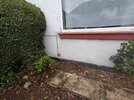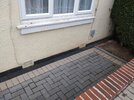You've had great advice on this thread and I think all the main points have been covered. Damp on walls can have all sorts of causes and is normal in our cool, damp climate. It can be caused by really common behaviour and nothing to worry about. It is always worth taking time to think it through carefully and identify, rule out, the different sources, and then patiently monitor, before resorting to expensive, possibly snake oil, solutions.
Some thoughts from my own experience...
- every person living in your home is producing moisture in the air when they breathe.
- boiling spuds n ribs on the hob produces huge amounts of moisture.
- women taking long baths and showers, producing vast quantities of moisture, then leaving the bathroom door open after they're finished... and then blow drying their soaked hair in another room...
All that moisture and more besides is going to find its way around your home and then condense on cold spots. Windows in winter, external walls, especially outside walls behind furniture.
I have these rules in my house:
- no furniture allowed against an outside wall. Minimum gap required to allow ventilation and enable me to monitor and take action if needed.
- bathroom door to be kept closed at all times, extractor fan on and window wide open after showers.
- kitchen door kept closed during cooking, and window or external door open, no matter how cold outside. Ventilation.
- no drying of clothes in the house unless in the dryer.
- use a dehumidifer for an hour or so a day in the colder months especially. Costs about 5p an hour with a modern one.
- generally try to ensure ventilation and home properly heated, even though it can be pricey.
If, after all that, you still have damp spots some months later after enough drying time, then other factors must be ruled out, more external to the home and your behaviour. You can isolate these earlier if there are obvious shortcomings.
I had a couple of damp bricks beneath the plaster in one room which I discovered when plaster and skirting boards removed. Surprise, Surprise, outside that very area, the previous owners had built up a big platform of muck and flag stones against the house, 1 brick below DPC, falling towards the house in a corner that never gets sun or wind on it. Tonnes of splashing from rain. I removed the lot. Now more than 2 bricks below DPC with a proper fall away from the house.
Another area with swollen plaster... dodgy old drain outside that wall which I had replaced, and reduced the ground level a bit, making a fall away from the house. The roofer later said water had been leaking into the cavity where main roof meets flat roofed extension. Now all replaced.
Finally, I disagree with those who say there is no such thing as rising damp. Bricks below DPC can be soaked and bricks above bone dry. That's the point of the DPC. If the DPC isn't there, is damaged, or bridged by paving or render, etc. then moisture can make its way above the DPC by capillary action. We might say the damp is "rising". So you cannot rule out fixing the DPC and there are chemical ways to achieve this, such as rods and so on. But there are many other issues to isolate first in my opinion.
Ps... if you've had moisture coming through the plaster at any point then there may be salts left behind from the evaporation process. Those salts can then attract moisture from the air. This is yet another angle. A special paint can neutralise salts.



